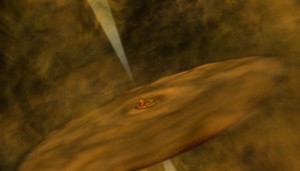Recent radio observations support the idea that brown dwarfs form like full-fledged stars do.
Brown dwarfs, which bridge the gap between stars and planets, have been an exciting target for astronomers since their discovery in the mid-1990s. Since that time, we’ve observed and classified hundreds of these objects, but the details of how they form still remain an active area of research. The answer to a simple question, "Do brown dwarfs form in a method similar to stars, or do they form more like planets?" has eluded astronomers for decades.

Credit: Bill Saxton / NRAO / AUI / NSF
The general picture of star formation is relatively clear. Massive clouds of gas, millions of times more massive than the Sun, collapse due to gravity. As the collapse ensues, clumps within the cloud begin to pull in material more rapidly than other, less dense regions. These overdensities create immense pressures and temperatures inside themselves (reaching over 25 million degrees Fahrenheit!). Eventually, the conditions for nuclear fusion are reached, and a star is born.
During this time, the star is still accreting material at a much smaller rate, spinning rapidly, and producing large magnetic fields. Thanks to the conservation of angular momentum, the rapid rotation also forms a disk out of the protostar’s birth cloud, in which smaller gravitational collapses may happen, resulting in planets.
But it’s unclear if brown dwarfs arise the same way. A group of astronomers led by Oscar Morata (Academia Sinica, Taiwan) has published results in the July 1st Astrophysical Journal that might go a long way in answering that question.
Brown dwarfs are often referred to as "failed stars." Spanning a mass range of about 13 to 80 times that of Jupiter, brown dwarfs lack sufficient pressures and temperatures in their cores to ignite nuclear fusion, the process that generates starlight. They start off with surface temperatures about one-third that of our Sun, and most of that heat is generated as the cloud that forms the brown dwarf collapses under its own gravity. This makes the youngest brown dwarfs the hottest and brightest members of their class. As time passes they slowly cool, like fireplace embers — but over billions of years.
The team targeted young brown dwarfs, because they haven't had a chance to cool off and are thus intrinsically brighter than older ones. The team was searching for jets, which astronomers commonly see coming from protostars but have not observed often from forming brown dwarfs.
Morata and his team imaged 11 proto-brown dwarfs using the Karl G. Jansky Very Large Array (VLA) radio telescopes in New Mexico. These objects are still in the process of forming and are still gravitationally accreting gas and dust. All of the young brown dwarfs sit in a star-forming region in Taurus about 450 light-years away, with an age of only about 1 million years.
Four of the young brown dwarfs showed radio emission due to jets, a hallmark of young, more massive stars. Jets are usually seen in young stars that are just forming, when the stellar magnetic fields are still very strong and the star is spinning rapidly. These magnetic fields can trap charged particles, supplied by strong protostellar winds, which emit radio waves as they accelerate around the fields. Observers have found that with normal stars, the strength of the magnetic fields, the amount of radio waves produced by particles spiraling through the jets, and the overall amount of proto-starlight produced are all related, with more massive (and therefore brighter) stars producing stronger magnetic fields and jets.
By comparing the strength of the radio waves emitted by the proto-brown dwarfs to the overall amount of light these forming objects produce, the team was able to show that these young brown dwarfs display the same behavior as their more massive stellar cousins.
“This is the first time that such jets have been found coming from brown dwarfs at such an early stage of their formation, and shows that they form in a way similar to that of stars," said Morata in an NRAO press release. "These are the lowest-mass objects that seem to form the same way as stars," he added.
This exciting discovery shows that brown dwarfs are more similar to stars than to planets. It also builds on past results, including computer simulations of star formation that not only also produced brown dwarfs, but a ratio of brown dwarfs to stars similar to that observed in our galaxy. Those simulations assumed that brown dwarfs formed in a similar way to stars, and the detection of jets further confirms this scenario. With new arrays such as ALMA coming online, we can expect to see more results on jets around brown dwarfs in the future.
Reference: O. Morata et al. "First Detection of Thermal Radiojets in a Sample of Proto-Brown Dwarf Candidates." Astrophysical Journal. July 1, 2015.
 2
2
Comments
Anthony Barreiro
August 6, 2015 at 12:55 pm
This is very interesting work. Brown dwarfs are odd creatures, not planets but also not quite stars. One question: this article states that "brown dwarfs lack sufficient pressures and temperatures in their cores to ignite nuclear fusion". But I thought it was a defining characteristic of brown dwarfs that they fuse deuterium early in their lives.
You must be logged in to post a comment.
Peter Wilson
August 8, 2015 at 12:43 pm
And what if future radio observations support the idea that gas giants form like full-fledged brown dwarfs do?
Will Jupiter and Saturn lose planetary status and become dwarf failed stars?
You must be logged in to post a comment.
You must be logged in to post a comment.